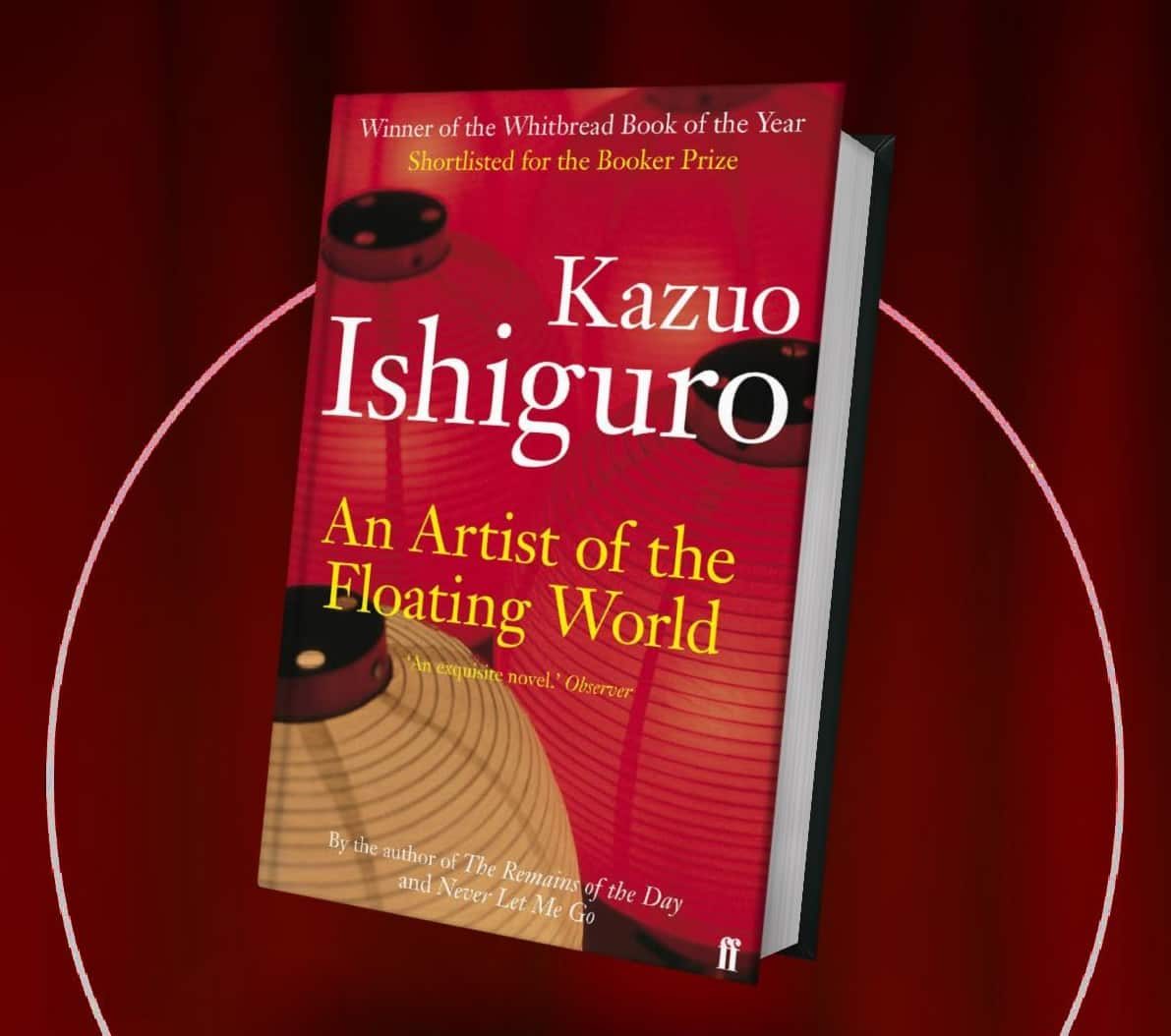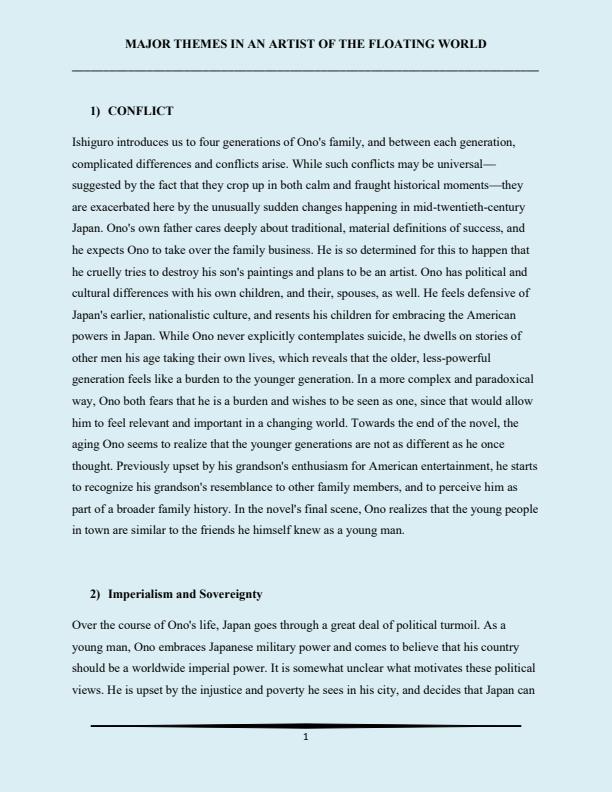An Artist Of The Floating World Themes
An Artist of the Floating World is a novel by Nobel Prize-winning British author Kazuo Ishiguro. Written in 1986, the novel explores themes of identity, memory, loyalty, and guilt in the life of an elderly Japanese artist named Masuji Ono who recalls his life during World War II. Set in post-war Japan, the novel examines the difficult transition between traditional Japanese culture and Western values that the country underwent in the wake of the war. Themes of regret and responsibility are explored throughout the novel as Ono reflects on how his decisions in life have affected his family and community. Additionally, the novel examines the notion of “floating world” – a term used to describe a world of impermanence, beauty, and pleasure – which is seen as a metaphor for the changing times and values of post-war Japan.
Overview of the Novel
Orientalism is a major theme in Kazuo Ishiguro’s novel ‘An Artist of the Floating World’. It follows the life of Masuji Ono, a retired painter living in postwar Japan. Through Masuji’s story, Ishiguro explores the complexities of Japan’s past, present, and future. In the novel, Ishiguro uses the term ‘floating world’ as a metaphor, to represent the transient nature of life, and how the past can haunt the present.
Ishiguro questions the power dynamics between East and West, and the power of imperialism. The novel is told from the point of view of Masuji, who was once a proud Japanese painter, but is now struggling to come to terms with his past. He is forced to confront his guilt and regret for his role in the war, and how his actions have impacted his family.
As the novel progresses, the themes of guilt, regret, and betrayal become more prominent. Ishiguro examines how the past can shape the present, and how people can find themselves caught between two worlds. The novel highlights the pain of the past, and explores how we can come to terms with our history. Ultimately, Ishiguro’s novel is a powerful exploration of the human condition, and the lasting effects of imperialism.
Themes of Japanese Identity and Culture
The Artist of the Floating World, written by Nobel Prize-winning author Kazuo Ishiguro, is a captivating novel that highlights the themes of Japanese identity and culture. The novel follows the story of Masuji Ono, an elderly painter who looks back on his life and his involvement in the political and cultural events of Japan during the 1930s and 1940s. In doing so, Ishiguro explores the themes of Japanese identity and culture, and how they have been shaped by the events of the time.
The novel examines the concept of identity, and how it can be shaped by the experiences of a person’s life. Masuji’s identity is shaped by his experiences during the war, and his struggles to reconcile his own beliefs with those of his society. This theme is further explored through Masuji’s relationships with his family and friends, and his attempt to come to terms with his past.
Ishiguro also examines the concept of culture, and how it can influence a person’s identity. Masuji’s journey is one of self-discovery, as he attempts to reconcile his own beliefs with those of his culture. As he travels through Japan, Masuji is confronted with a variety of cultural influences, from the traditional values of his hometown to the modernity of the city. This theme is explored through Masuji’s interactions with his family and friends, as well as his conversations with strangers.
The Artist of the Floating World is a masterful exploration of the themes of Japanese identity and culture. Through Masuji’s journey, Ishiguro highlights the importance of self-discovery and understanding one’s culture in order to truly understand oneself. The novel is an engaging and thought-provoking look at the themes of identity and culture in modern Japan.
Themes of Ambiguity and Uncertainty
The Artist of the Floating World is a novel by Nobel-prize winning author Kazuo Ishiguro that weaves a complex and thought-provoking narrative that speaks to themes of ambiguity and uncertainty. Through the story of the protagonist, Masuji Ono, Ishiguro examines the themes of identity, morality, and responsibility in a post-war Japan. The novel’s themes of ambiguity and uncertainty are explored through the duality of Ono’s identity – a man who is both a respected artist of the pre-war era and a disgraced former soldier of the Imperial Japanese Army.
The novel explores how Ono navigates his way through the ambiguities of life and morality, making difficult decisions and choices that are often fraught with uncertainty. Ono’s personal journey and his attempts to reconcile his past and present selves is a powerful example of how individuals must grapple with the complexities of life and its many conflicting demands.
Ishiguro’s novel is a masterful and insightful exploration of the human experience. Through the character of Ono, the author delves into the complexities of morality, identity, and personal responsibility in a post-war Japan. Themes of ambiguity and uncertainty are explored in a thoughtful and profound manner that speaks to the universal human experience.

Themes of Post-war Japan
in An Artist of the Floating World by Kazuo Ishiguro
Kazuo Ishiguro’s novel, An Artist of the Floating World, is a powerful exploration of post-war Japan and its effects on individuals and their relationships. The novel follows Masuji Ono, an aging artist living in Nagasaki, as he reflects back on his life and the choices he made during the war. Themes of guilt, regret, and the struggle to find meaning in a post-war world are woven throughout the novel, creating an immersive experience of the time period.
Ishiguro’s use of imagery and symbolism emphasizes the themes of the novel, in particular those of guilt and regret. The floating world, a phrase taken from traditional Japanese art, is used throughout the novel to symbolize the intangible nature of the post-war world and the difficulty of finding one’s place in it. The use of the cherry blossoms in the opening scene is particularly moving, as it is a reminder of the fragility of life and the importance of cherishing every moment.
The novel also explores the idea of identity in the post-war period, as Ono struggles to reconcile his role in the war with his current identity. His search for meaning is further complicated by the changing attitudes of the people around him, who are either trying to forget the war or clinging to the past. The absence of a clear moral framework further complicates the themes of the novel, as Ono is left to grapple with his own sense of morality and justice.
An Artist of the Floating World is an insightful and powerful exploration of the effects of post-war Japan on individuals and their relationships. Through the use of symbolism and imagery, Ishiguro paints a vivid portrait of the time period and its impact on those living through it. It is a must-read for anyone interested in understanding the effects of war and the complexities of the human experience.
Themes of Family and Loyalty
in An Artist Of The Floating World
Kazuo Ishiguro’s novel An Artist of the Floating World is a profound exploration into the intricacies of family and loyalty. The story follows Masuji Ono, an aging artist living in post-World War II Japan. He faces immense guilt and regret over his actions during the war, as well as a conflict between his desire to remain loyal to his family and society’s expectations of him. The themes of family and loyalty are explored through Masuji’s struggles with his past, his relationships with his children, and his decision to embrace or reject the new social order.
Masuji’s family is central to the novel, and he goes to great lengths to preserve their legacy. He works hard to ensure that his children grow up in a society that respects their family’s history and values. This is juxtaposed against Masuji’s own feelings of regret over his past actions. He feels torn between his loyalty to his family and his guilt over his actions. This leads to an internal struggle throughout the novel as Masuji wrestles with his identity and his place in society.
The theme of loyalty is also explored through Masuji’s relationship with his children. He is determined to provide them with opportunities that he never had, but at the same time he is concerned about their future. He fears that they may adopt views that contradict his own, and this causes him to question his loyalties.
Ultimately, An Artist of the Floating World is a powerful story that deals with the complexity of family and loyalty. Through Masuji’s struggles, Ishiguro is able to explore the nuances of these themes and demonstrate the difficulty of making decisions in an ever-changing world.
Themes of Redemption and Forgiveness
in An Artist of the Floating World
Set in post-war Japan, Kazuo Ishiguro’s An Artist of the Floating World is a story of redemption and forgiveness. It follows the life of Masuji Ono, an elderly artist who looks back on his life and career, and the choices he made during the war. The novel touches on themes of personal responsibility, loyalty, and the consequences of one’s decisions. While Masuji’s actions during the war have caused him to be shunned in the eyes of the public, he is able to find redemption in the form of forgiveness from those he has wronged. He learns to forgive himself, and to forgive those who have wronged him. He discovers that redemption can be found in the simple act of apologizing and forgiving, and finds that he can still find joy in life despite his past mistakes. The novel ultimately shows that redemption and forgiveness are possible, regardless of the circumstances, and can lead to a life of true happiness and fulfillment.
FAQs About the An Artist Of The Floating World Themes
Q1: What themes are explored in the novel “An Artist of the Floating World”?
A1: The novel explores themes of identity, redemption, regret, and coming to terms with the past. Masuji Ono, the main character, is forced to confront his past actions and find a way to reconcile with his conscience.
Q2: How does the title “An Artist of the Floating World” relate to the novel’s themes?
A2: The title “An Artist of the Floating World” refers to the idea of living in an ever-changing world. Ono is forced to confront his past actions and the consequences of his decisions, and must find a way to exist in a world that is constantly shifting.
Q3: What does the title “An Artist of the Floating World” signify?
A3: The title “An Artist of the Floating World” is symbolic of Masuji Ono’s journey to reconcile his past and find a way to exist in an ever-changing world. The title is also a reflection of the novel’s themes of identity, redemption, and regret.
Conclusion
In An Artist of the Floating World, author Kazuo Ishiguro explores the themes of regret, guilt, and responsibility in a post-war Japan. Through the story of Masuji Ono, Ishiguro delves into how the legacy of the war and its consequences affects a person’s life, and how a single misstep can have dire repercussions. Ono’s story is one that is both tragic and inspiring, and it shows how one can transcend the past and move forward with grace, dignity, and acceptance. The novel ultimately serves as a reminder to all of us that we must take responsibility for our own actions and be mindful of how our choices shape our future.




